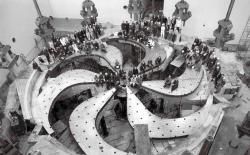
At 3:30 pm on 15 December 1974, the first 500 MeV proton beam was extracted from the TRIUMF cyclotron. Since then, TRIUMF has used proton beams from its cyclotron (and secondary beams of pions, muons, neutrons and radioactive ions produced in its experimental halls) to conduct pioneering studies that have advanced nuclear physics, particle physics, molecular and materials science, and nuclear medicine.
TRIUMF is the world's largest cyclotron, and one of only five intermediate-energy high-intensity accelerators in the world. The TRIUMF design team was among the first to adopt the use of H- ions to simplify beam extraction and the use of an AVF (azimuthally varying field) main magnet to permit both isochronous acceleration and proper focusing of the H- ions even as they reach relativistic velocities. They also pioneered the simultaneous extraction of multiple (up to 4) beams at independently variable energies (70-520 MeV).
(H- ion beams can be easily extracted from the cyclotron by passing them through a stripping foil that removes the two electrons from each ion. If the foil is correctly positioned, the resulting proton beam simply curves in the opposite direction, out of the cyclotron's beam port and into the beamline. The fragility of H- ions limits the magnetic field strength that can be used, accounting for the large size of the cyclotron.)
Unlike the world's other four intermediate-energy high-intensity accelerators (the two other meson factories located at the Paul Scherrer Institut near Zurich and the Los Alamos National Laboratory in New Mexico, the SNS linear accelerator located near Oak Ridge, TN and the ISIS synchrotron located in Oxfordshire, UK, respectively), the TRIUMF cyclotron can deliver multiple variable-energy and full-energy proton beams simultaneously with a 100% macroscopic duty cycle.
The high intensity of the beam allows the cyclotron to serve as the driver for multiple experiments within the course of a week. The TRIUMF cyclotron’s ability to provide steady, intense and reliable energy beams in a flexible manner has also allowed the facility to become a world leader in providing beams of exotic isotopes using the "isotope separation online" technique.


